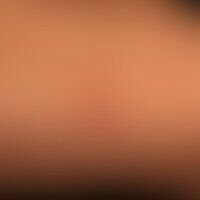Image diagnoses for "Leg/Foot"
404 results with 1180 images
Results forLeg/Foot

Lymphedema (overview) I89.00
Lymphedema: one-sided, skin-coloured swelling due to insufficient transport capacity of the lymphatic vessel system; swelling of the toes and back of the foot (Stemmersches sign: positive).

Pemphigus vulgaris L10.0
Pemphigus vulgaris:multiple, chronic, since 3 years intermittent, symmetric, trunk accentuated, easily injured, flaccid, 0,2-3,0 cm large, red blisters, which confluent to larger, weeping and crusty areas, here infestation of the hollow of the knee.

Cimicose T00.9
Cimicosis: acutely (overnight) erect, grouped standing, 0.3-0.4 cm large, bright red, eminently itchy papules and papulovesicles.

Bowen's disease D04.9
Bowen's disease with transition to Bowen's carcinoma: solitary, size-progressive plaque that has been present for several years, occasionally accompanied by itching, sharply and arc-shaped, border-emphasized plaque with increasing verrucous nodular formation (see following figure).

Lipogranulomatosis subcutanea M79.8

Old world cutaneous leishmaniasis B55.1

Vasculitis leukocytoclastic (non-iga-associated) D69.0; M31.0
Vasculitis, leukocytoclastic (non-IgA-associated). multiple, acute, symmetric, localized on both lower legs for 1 week, irregularly distributed, 0.1-0.2 cm large, sharply defined, symptomless, red, smooth patches (non-compressible). Occurrence after flu-like infection and ingestion of a non-steroidal anti-inflammatory.

Papillomatosis cutis lymphostatica I89.0
Papillomatosis cutis lymphostatica 14 days after keratolytic therapy.

Necrobiosis lipoidica L92.1
Necrobiosis lipoidica: 44-year-old woman. 10 years ago, fracture of the ankle joint with surgical treatment, for about 8 years beginning changes in the scars on the inner and outer ankle. Histologically, a necrobiosis lipoidica could be confirmed. On request, she was under constant diabetological control, since both previous pregnancies had been accompanied by insulin-dependent gestational diabetes.

Squamous cell carcinoma of the skin C44.-
Squamous cell carcinoma of the skin: chronically persistent, for several years existing, slowly progressing in size, weeping and bleeding for 12 months, rough, red, rough, crusty plaque on the right forearm of an 85-year-old patient. Before histological confirmation of the correct diagnosis, the disease was misdiagnosed as psoriasis and fungal disease by several practitioners due to the unusual localization.

Erythema migrans A69.2
Erythema migrans: about 2-3 months old with slow peripheral expansion; painless, non-itching, circular erythema which is well distinguishable from normal skin; the bite is still centrally visible.

Eosinophilic cellulitis L98.3
Cellulitis eosinophil: acute formation of circumscribed, large, sharply margined plaques The surface of the plaques may have an orange peel-like texture (see following figure)

Granuloma anulare plaque type
Granuloma anulare, plaque type: multiple, completely symptomless, faded in the center, smooth, painless anular plaques.











